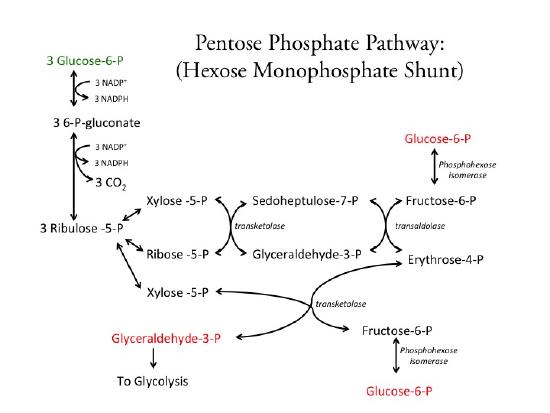Pentose Phosphate Pathway*#
- Page ID
- 14544
( \newcommand{\kernel}{\mathrm{null}\,}\)
Introduction into the pentose phosphate pathway
Most introductory biology and biochemistry courses focus on glycolysis (oxidation of glucose to pyruvate) and the TCA cycle (oxidation of pyruvate to acetyl-CoA and the eventual complete oxidation to CO2). While these are extremely important and universal reactions, most courses leave out the pentose phosphate pathway (PPP) or hexose monophosphate shunt. This pathway, like the TCA cycle, is partially cyclic in nature in which three glucose molecules enter and two glucose and one glyceraldyde-3-phosphate (G3P) leave. The two glucose molecules can recycle, and the G3P enters glycolysis. Its an important pathway because it is the primary mechanism for the formation of pentoses, the five-carbon sugar required for nucleotide biosynthesis as well as the formation of a variety of other essential cellular components and NADPH, the cellular reductant primarily used in anabolic reactions.
A note from the Instructor
As with the modules on glycolysis and the TCA cycle, there is a lot of material in this module. As with the other modules, I do not expect you to memorize specific names of compounds or enzymes. However, I will give you those names for completeness. For exams, I will always provide you with the pathways we discuss in class and in the BioStax Biology text modules. What you need to be able to do is understand what is going on in each reaction. We will go over in lecture problems that will be similar to those I will ask of you on exams. Do not be overwhelmed with specific enzyme names and specific structures. What you should know are the general types of enzymes used and the types of structures found. For example, you do not need to memorize the structures of eyrthose or sedoheptulose. You will need to know that both are sugars, the former a four-carbon sugar and the latter a seven-carbon sugar. Remember the ending "ose" identifies the compound as a sugar. In addition, you will not need to know the details of the two unique reactions found in the PPP, the transketolase and transaldolase reactions, though you do need to be able to identify a ketone containing sugar versus an aldehyde containing sugar. Finally, you will not be expected to memorize enzyme names, but like in glycolysis and the TCA cycle, you will be expected to know the various types of reactions a type of enzyme can catalyze, for example, a transaldolase moves aldehyde groups from one compound to another. This is the level of understanding I expect. If you have any questions please ask.
Oxidative pentose phosphate pathway: a.k.a., the hexose monophosphate shunt
While glycolysis has evolved to oxidize hexoses to form carbon precursors for biosynthesis, energy (ATP), and reducing power (NADH), the Pentose Phosphate Pathway (PPP) has evolved to utilize pentoses or five-carbon sugars. Pentoses are required precursors for nucleotides and other essential biomolecules. Instead of NADH, the PPP also generates NADPH which is required for most anabolic reactions. The PPP, in conjunction with glycolysis and the TCA cycle, make up what we call Central Metabolism. These three central pathways (along with the reaction pyruvate to Acetyl-CoA) are responsible for producing all of the necessary precursor molecules required by all cells. The PPP is responsible for producing pentos-phosphates (give carbon sugars), eyrthrose-phosphate (four-carbon sugars), and NADPH. This pathway is also responsible for the production of sedoheptulose-phosphate, an essential seven-carbon sugar used in the outer cell membranes of Gram-negative bacteria.
Below is a diagram of the pathway. The pathway is complex and involves a variety of novel rearrangement reactions that move two and three carbon units around. These reactions called transaldolases and transketalases are used to produce the intermediates within the pathway. The net result is oxidation and subsequent decarboxylation of glucose to form a pentose. The total reaction involves three glucose-6-phosphate (in green) molecules being oxidized to form three CO2 molecules, one glyceraldehyde-phosphate (in red), and two hexose-phosphates (in red). In this cycle, the formed glyceradehyde-phosphate feeds into glycolysis and the two hexose-phosphates (e.g., glucose-phosphates) can recycle into the PPP or gycolysis.
As shown in Figure 1, the net result of the pathway is one trios-phosphate (glyceraldehyde-3-phosphate) that can then be further oxidized via glycolysis, two recycled hexose-phosphates (in the form of either glucose-6-phosphate or fructose-6-phosphate), and NADPH which is a required reductant for many biosynthetic (anabolic) reactions. The pathway provides a variety of intermediate sugar-phosphates that the cell may require, such as pentose-phosphates (for nucleotides and some amino acids), erythrose-phosphate (for amino acids) and sedohepulose-phosphate (for gram-negative bacteria).
The PPP along with glycolysis, the TCA cycle, and the oxidation of pyruvate to acetyl-CoA makes up the major pathways of central metabolism and is required to some degree of all organisms to construct the basic substrates to create the building blocks of life.
Section summary
By the end of this module you should be able to describe the role the pentose phosphate pathway plays in central metabolism and determine the end products of the pathway.


